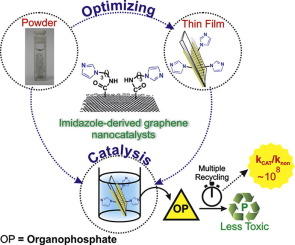Journal of Catalysis ( IF 7.3 ) Pub Date : 2017-11-06 , DOI: 10.1016/j.jcat.2017.10.008 Leandro Hostert , Sirlon F. Blaskievicz , Jéssica E.S. Fonsaca , Sergio H. Domingues , Aldo J.G. Zarbin , Elisa S. Orth

|
Promoting efficient organophoshate (OP) destruction has been of increasing interest, mainly due to their highly toxic nature and broad use as agrochemicals and chemical warfare. It is known that OP destruction can only be accomplished in the presence of catalysts, since they are knowingly stable. Hence, multifunctional materials have been targeted for this purpose since they can combine catalytic sites with features that enable easy handling, sensor projection for monitoring misuse and even large-scaled detoxification methods. Herein, we developed nanocatalysts derived from graphene oxide, which comprises reactive imidazole groups anchored by covalent functionalization. Two approaches were adopted: (i) a mild aqueous reaction leading to a powder, namely GOIMZ1; and (ii) a liquid/liquid interfacial functionalization, resulting in the thin film GOIMZ2. The nanocatalysts were applied in the destruction of OP and in the case of the toxic pesticide Paraoxon, impressive rate enhancements were obtained (108-fold). Both catalysts were consecutively recycled, maintaining overall characteristics. We highlight the feasible handling of the nanocatalysts, that in the case of the powder, it can be easily filtered, washed and reused. For the thin film, the handling is even more practical, since it can be immersed in the contaminated media and separated easier than the powder. Overall, we show novel imidazole-derived nanocatalysts with promising catalytic efficiency towards OP destruction, which have potential for projecting sensors and detoxification processes, especially with the thin films.
中文翻译:

咪唑衍生的石墨烯纳米催化剂用于有机磷酸酯的破坏:粉末和薄膜异相反应
促进有效销毁有机磷(OP)引起了越来越多的关注,这主要是因为它们的剧毒性质以及广泛用作农用化学品和化学战。已知OP破坏只能在催化剂存在下完成,因为已知它们是稳定的。因此,多功能材料已被用于此目的,因为它们可以将催化部位与易于操作的特征,用于监视滥用的传感器投影甚至大规模的排毒方法相结合。在这里,我们开发了由氧化石墨烯衍生的纳米催化剂,其包含通过共价官能化锚定的反应性咪唑基团。采用了两种方法:(i)温和的水性反应导致粉末,即GOIMZ1;(ii)液/液界面功能化,产生薄膜GOIMZ2。纳米催化剂被用于破坏OP,在有毒农药Paraoxon的情况下,获得了令人印象深刻的速率提升(108倍)。两种催化剂都连续循环使用,保持了整体特性。我们重点介绍了纳米催化剂的可行处理方法,对于粉末而言,可以轻松过滤,洗涤和重复使用。对于薄膜,处理甚至更为实用,因为它可以浸入受污染的介质中,并且比粉末更容易分离。总的来说,我们显示出新颖的咪唑衍生的纳米催化剂,对OP的破坏具有令人鼓舞的催化效率,这对于投射传感器和解毒过程(尤其是薄膜)具有潜力。


























 京公网安备 11010802027423号
京公网安备 11010802027423号